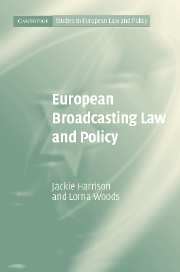Book contents
- Frontmatter
- Contents
- Series Editors' Preface
- Preface
- Case list
- PART I
- PART II
- 6 Access
- 7 Media ownership: impact on access and content
- 8 Jurisdiction, forum shopping and the ‘race to the bottom’
- 9 Advertising placement and frequency: balancing the needs of viewers and commercial interests
- 10 Negative content regulation
- 11 Positive content regulation: quotas
- 12 Privatisation of sport and listed events
- 13 State aid: constraints on public service broadcasting
- PART III
- Appendix
- Bibliography
- Index
10 - Negative content regulation
Published online by Cambridge University Press: 29 July 2009
- Frontmatter
- Contents
- Series Editors' Preface
- Preface
- Case list
- PART I
- PART II
- 6 Access
- 7 Media ownership: impact on access and content
- 8 Jurisdiction, forum shopping and the ‘race to the bottom’
- 9 Advertising placement and frequency: balancing the needs of viewers and commercial interests
- 10 Negative content regulation
- 11 Positive content regulation: quotas
- 12 Privatisation of sport and listed events
- 13 State aid: constraints on public service broadcasting
- PART III
- Appendix
- Bibliography
- Index
Summary
Introduction
Negative content regulation places restrictions and prohibitions on the broadcasting of certain types of material in order to protect viewers. A sensitive and contentious area even within a single member state, negative content regulation is even more problematic in the Union and external factors have exacerbated this. Increased numbers of channels has led to a fight for audience share, and some broadcasters have pushed at moral and cultural boundaries to attract viewers. At the same time, negative content regulation is increasingly being seen as unnecessary since viewers, in a multi-channel environment, have the technology to filter out unwanted programming. Traditional regulatory measures, on this reasoning, can be replaced not only by soft-law approaches but by technology. As we shall argue, these developments may not be entirely desirable as they make assumptions about viewers' ability, and do not take into account personal and environmental factors affecting both consumer and citizen viewers (chapter 1).
Although crucial to the viewing experience, content regulation within the Union is problematic because it falls across boundaries in competence. Member states may determine their own regulatory system in the light of standards obtaining within their respective territories, although their complete freedom to regulate content is constrained by the EC Treaty (see chapter 4). The approach taken to jurisdiction (chapter 8) generally in the Television without Frontiers Directive (TWFD) means that viewers may be able to receive broadcasting which is regulated by a different member state from that in which they are established, and whose rules and regulations about programme content may be unfamiliar.
- Type
- Chapter
- Information
- European Broadcasting Law and Policy , pp. 218 - 242Publisher: Cambridge University PressPrint publication year: 2007



